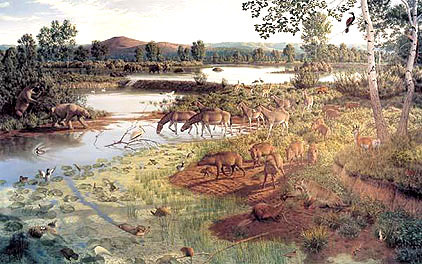Hagerman Valley Paleoecology
CLICK on the mural to learn about some of Hagerman's species.

An artist rendition of the ecosystem when Hagerman Fossil Beds were deposited
during the Pliocene Epoch (original at the Smithsonian
Institute ).
The strata and fossils at Hagerman Fossil Beds have revealed a remarkable glimpse into the Pliocene Epoch. The area was once a floodplain on the eastern margin of a large lake known as Lake Idaho . Lake Idaho received much of its sediment from the ancestral Snake River and other peripheral streams, and layers of sand, silt and clay at least 600 feet thick were deposited in the area. These layers of sediment have preserved an assemblage of Pliocene fossils.
The environment was much different than the sagebrush landscape we see today and has been classified as savanna-like, with higher annual rainfall, isolated patches of pine woodland and abundant hardwood trees growing along the bodies of water including willow, alder, birch and elm.
Numerous vertebrate species associated with aquatic habitats including pelicans, herons, egrets, storks, swans, geese, frogs and numerous fish indicate that the overall environment during this time was wetter.
In addition to the above mentioned species, fossil aquatic mammal remains are common and include ancestral muskrat, extinct beaver (a relative of the modern beaver), and otter which help to support the wetter environment scenario. Also important to mention is the great Mastodons, Lakecats, camels, llamas, shrews, giant marmots, grison, ground sloths, moles and the hyena-like dogs the lived around the watering hole.
Invertebrate species, such as snails, were also abundant.
VISIT the fossil bone photo archive for additional examples of Hagerman's paleofauna.
Click here and review a discussion of the paleoecology of the Hagerman area.